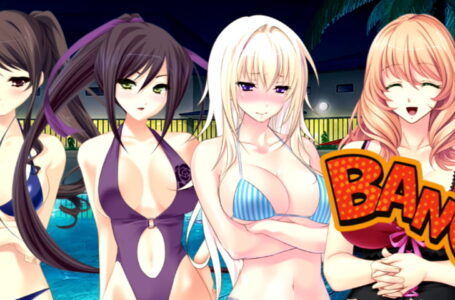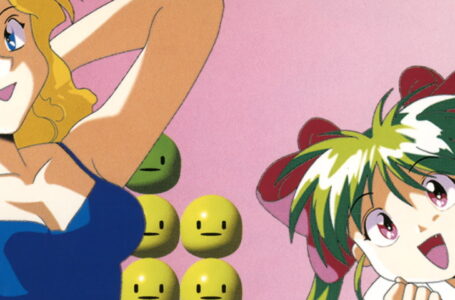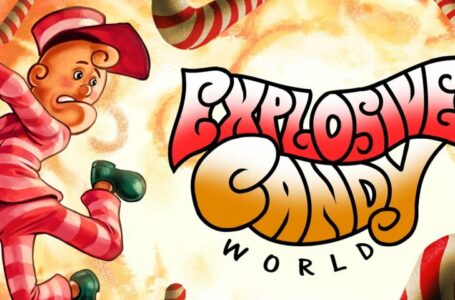The History of Magical Drop
As I type this, Magical Drop VI has just been announced, promising us a joyful reunion with a classic frantic puzzler series that originated with Data East — and which formed the basis of many a forum signature in the early 2000s.
So far the game has been announced for release on Nintendo Switch in winter of 2022, with no news on other platforms as yet — PlayStation and PC players, cross your fingers. Or buy a Switch. (Xbox owners, you already knew you were never, ever going to see this game, right?)
The new game is the work of publisher Forever Entertainment and developers Highball Games and Storm Trident, both of whom are subsidiaries of Forever. Highball Games is a French developer whose English language option doesn’t work on their website, while Storm Trident is a Polish outfit whose previous titles include dinosaur-themed platformer Tiny Hands Adventure and tower defence title Assault on Metaltron, both of which are relatively little-known but fairly well-regarded indie titles for PC.
Details on the new game are relatively thin on the ground at the moment, but the new trailer shows that the game features a high-definition anime-inspired art style with animated characters, The World’s titties present and correct, and Empress still being everyone’s favourite bondage queen. It seems there will be a variety of game modes on offer, including a timed caravan mode, a puzzle mode and a story mode as well as the main versus option. There’s also a mode called “Path of Destiny”, but this hasn’t been explained as yet.
So in lieu of being able to talk too much more about the upcoming new game, I thought we’d take a brief look back at the history of the mainline installments in the series — including where it came from in the first place. So let’s kick off, shall we?
Drop-Drop (1992)
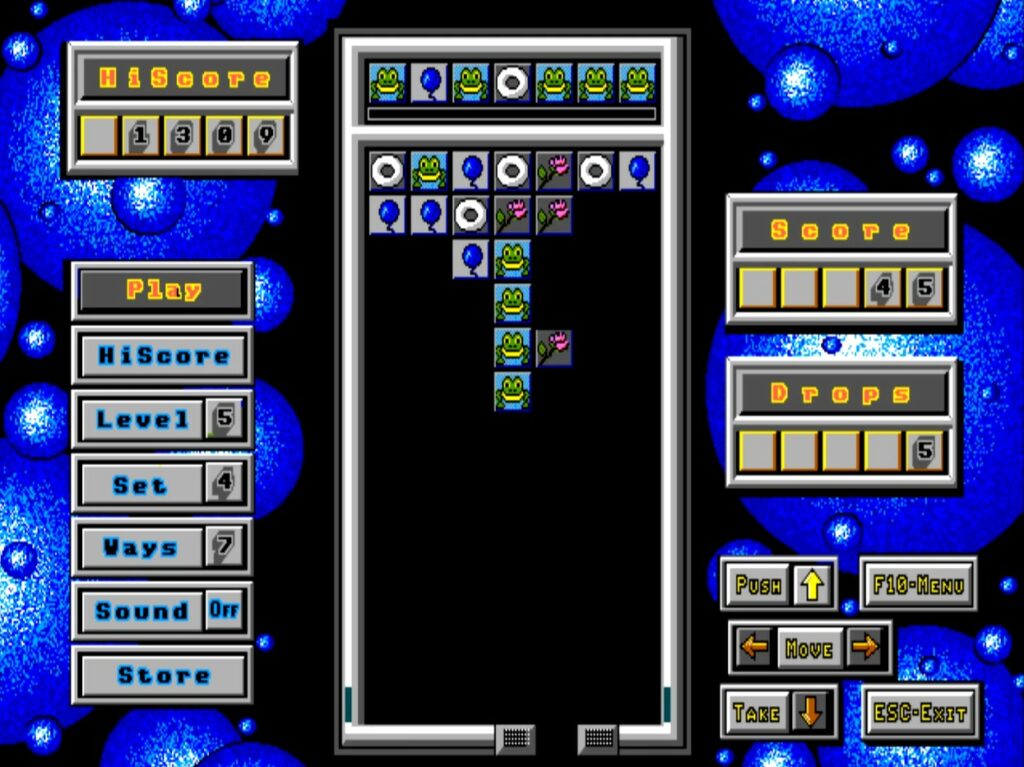
Like any good commercially successful puzzle game, Magical Drop is a ripoff of something else. In this case, it’s a Russian MS-DOS puzzler named Drop-Drop, which released in 1992.
Drop-Drop is immediately recognisable as what would become Magical Drop through its basic mechanics of grabbing coloured objects and attempting to create columns of them, but there are a few notable differences. Firstly, Drop-Drop requires you to create stacks of five objects rather than the three of Magical Drop, and secondly there are a lot of options to tweak how the basic single-player game modes, rather than the selection of discrete game modes that the later Magical Drop games have.
For example, you can choose how many different types of pieces will appear in a game, as well as the overall width of the well. You can also choose a starting level, which affects both how quickly new rows of pieces appear at the top of the screen and the number of points you score for creating successful matches. In a rather nice touch, high scores are kept independently for all the different combinations of options, so you can challenge yourself to get the best scores under various different conditions and easily keep track of your finest performances.
Drop-Drop’s main weakness compared to Magical Drop is that its presentation is a bit dry. Its graphics are functional and clinical rather than filled with personality, and its PC speaker sounds — turned off by default — are pretty woeful. Still, it plays well — and clearly someone at Data East thought so, because they went and nicked the idea for the first Magical Drop in 1995.
Magical Drop/Chain Reaction (1995)
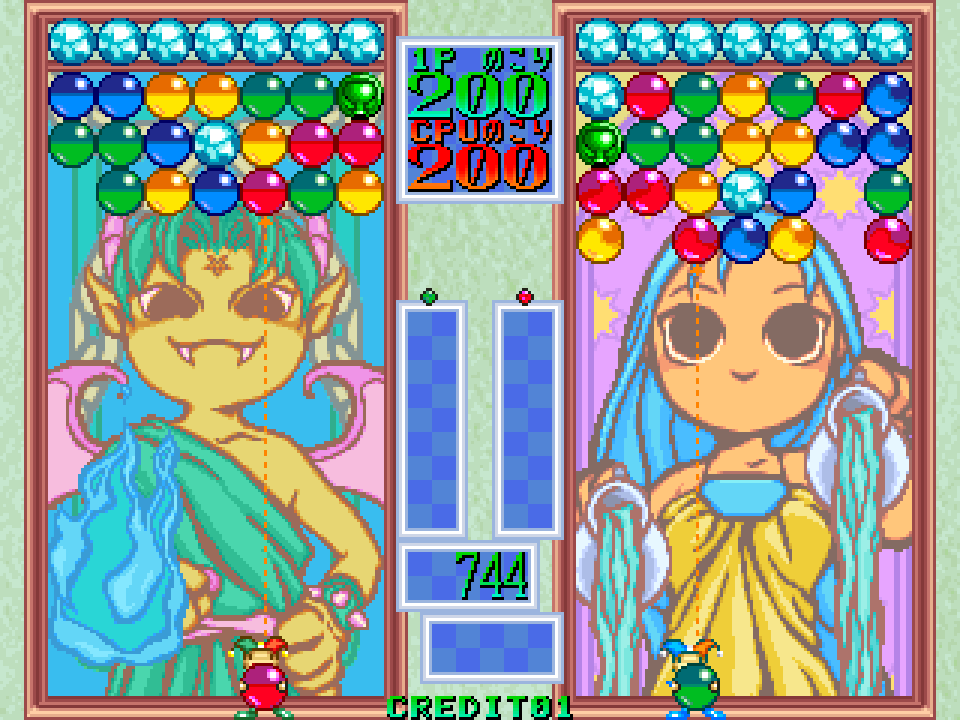
Like many ’90s puzzlers, Magical Drop’s first appearance was as an arcade machine, known as Magical Drop in Japan but Chain Reaction in the west. The game introduced the basic gameplay of Magical Drop and several of the series’ iconic characters, including the snot-dribbling Fool, the Magician, the High Priestess, the Chariot, the Devil, the Star and the World (she of Fairy Bounce fame). Notably, the World wasn’t a playable character; instead, she was the final boss of the game.
The first Magical Drop actually had a few different releases. The most well-known of these are the Japanese arcade version Magical Drop Plus 1! which introduces a solo play mode as well as the competitive versus mode of the initial release, and the localised arcade version Chain Reaction, which changes the coloured drops into food items and stars and replaces the character-specific voice acting with a male narrator. This latter version is available for Evercade as part of the Data East Arcade 1 cartridge.
There were also PlayStation and Saturn ports that replaced the lovely pixel art of the original with some truly horrifying pre-rendered characters; this version is known as the “Arcade Hits” release. A little later, the game got a second PlayStation port as a bonus disc that came with the PlayStation version of Magical Drop III; this was a more direct port of the Magical Drop Plus 1! arcade version.
Magical Drop II (1996)
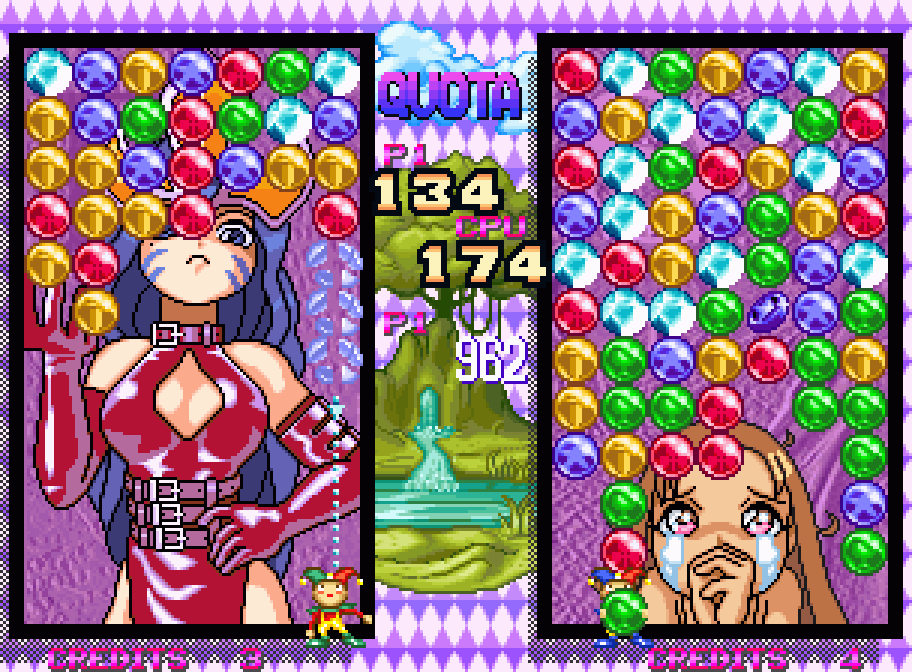
Following a year later, Magical Drop II was developed for SNK’s Neo Geo hardware as opposed to the proprietary arcade hardware the first game was built for. While fundamentally pretty similar to the first game in terms of basic mechanics, Magical Drop II features a number of refinements and tweaks that arguably make it a little more enjoyable to play and accessible.
Most notable of these is the change in behaviour for Special pieces on the board; in the first Magical Drop, in order to take advantage of these (and clear all the pieces of a particular colour or type from the board) you had to make a complete match of three Special pieces; Magical Drop II relaxed this requirement to simply creating a match containing at least one Special piece. Magical Drop II also introduced Rainbow pieces, which both act as wild cards and become Special pieces when incorporated into a match.
The single-player mode was also revamped to make use of a much wider playfield, and bringing in a wider variety of piece types to contend with. The various difficulty modes correspond to the different characters, with the Fool and World being the easiest and most difficult respectively. They only appeared in the Super Famicom port — in the arcade original, you can play as Devil for a medium-difficulty game, or High Priestess for a hard game. In the Japanese arcade version, you can also play a Star for an expert-level challenge.
Like its predecessor, Magical Drop II had several releases. The North American Neo Geo release strips out the original Japanese voice acting and replaces it with the announcer from Chain Reaction, as well as removing all character endings, the puzzle-like Flash mode and the Expert difficulty for the single-player mode. The European version is almost identical to the North American version, but features localised voice acting for different languages.
Of particular note is the Super Famicom version, which is tweaked slightly from the arcade original. Here, there are six columns in the playfield instead of the seven of the arcade version, and there are a few additional options, including a time attack mode.
This version went unlocalised until 2018, when fan translation group Aeon Genesis, who had previously announced their intention to create an English patch for the game back in 2012, partnered with Retro-Bit to release an officially licensed translation. This version was released to the English-speaking public both as part of Retro-Bit’s Data East Classic Collection cartridge for the Super NES, the Super Retro-Cade plug and play system, and the Evercade — the latter version forms part of the Data East Collection 1 cartridge.
Interestingly, a completely separate localisation — seemingly an unreleased official translation — was also discovered, and this version can be found as part of the Nintendo Switch Online’s Super NES app. And then, of course, you can also play the Neo Geo version in both its Japanese and North American forms thanks to the ACA Arcade Archives series.
Magical Drop III (1997)
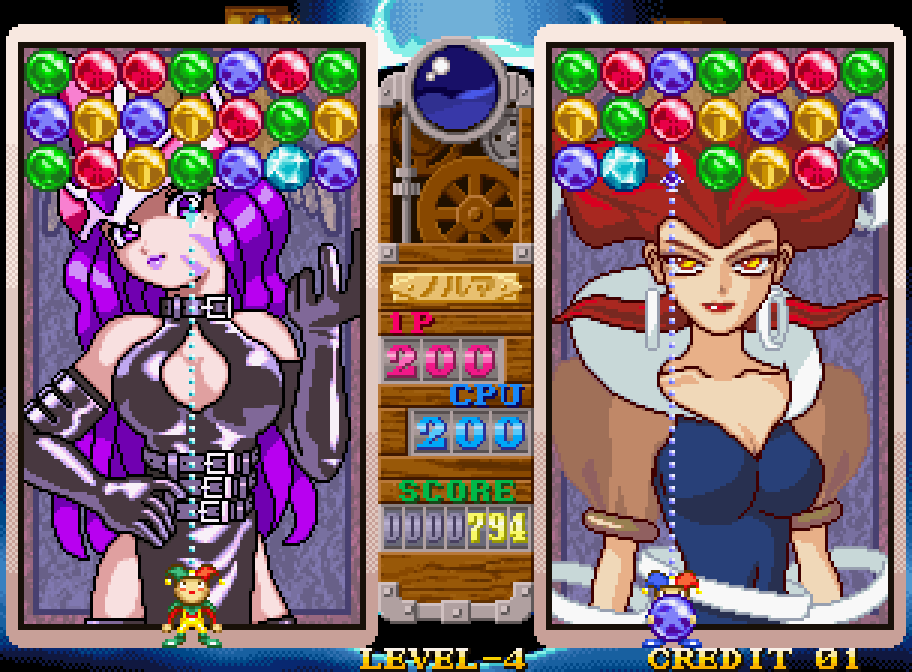
Magical Drop III once again keeps the same basic gameplay, but adds an additional button allowing players to deliberately summon a new line of balloons into their field. It’s also now possible to grab special and normal pieces at the same time, whereas in previous games they had to be grabbed separately.
Magical Drop III also introduces unique attack patterns for each character, which trigger when achieving combos or chain reactions in the competitive modes. Now, certain characters will summon more pieces in particular positions on the screen, meaning that when fighting against them you’ll want to try and keep that part of the field clear. And speaking of characters, Magical Drop III adds enough new players to represent all of the 22 major Arcana.
Structurally, the most notable addition is the Magical Journey or Adventure mode, which unfolds like a board game. By playing short 60-second minigames based on the Magical Drop core rules, you earn the ability to move across the board, with your eventual aim being to reach Empress and defeat her in a battle.
The Japanese version of this mode sees the player competing against three rivals, who can be defeated in duels by landing on them — but who trigger a bad ending if they reach Empress first — while the localised releases make this a solo mode, with various challenges according to which spaces you land on.
Once again, there are numerous different versions of Magical Drop III out there. The North American and European versions once again cut out the Japanese voice acting and a few game modes, as well as making the aforementioned changes to the Magical Journey mode. A Sega Saturn version features rebalanced gameplay at a slower pace, while the first of two Japanese PlayStation releases features both a port of the arcade original and a rebalanced version similar to the Saturn port.
One of the best versions of Magical Drop III is the second PlayStation release, known as Magical Drop III + Wonderful in Japan, and simply Magical Drop III in Europe. This features the rebalanced version of Magical Drop III, retains the Japanese voice acting and includes a port of Magical Drop Plus 1! — as such, it’s one of the most comprehensive Magical Drop packages out there.
Magical Drop F – Daibouken mo Rakujyanai! (1999)
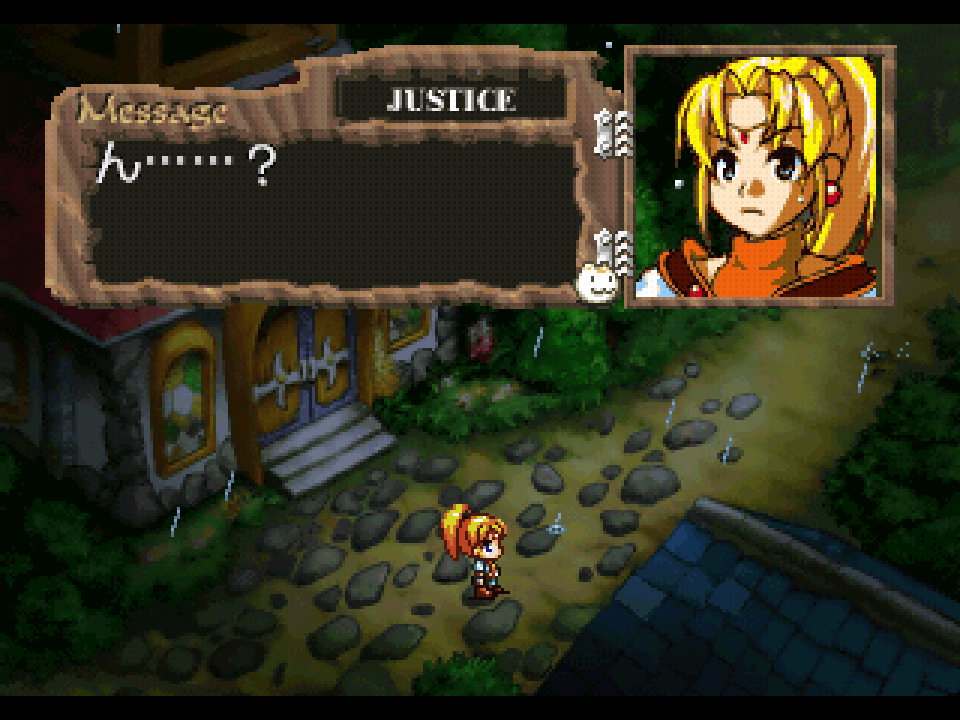
There is no Magical Drop IV; instead, we have this Japan-exclusive, PlayStation-only release. It was noteworthy for a bit of a change in art style, replacing the somewhat deformed anime-style art of previous installments with characters who had somewhat more realistic proportions.
Gameplay-wise, Magical Drop F features character-specific items that have particular effects when activated, providing incentive to try playing the game in different ways. There’s also a full-on RPG-style mode in Magical Drop F, which is likely the main reason it never saw a localisation into English.
With puzzle games already being fairly niche-interest by 1999, a text-heavy RPG mode would have likely made a translation impractical. A pity, as the game is a particularly good-looking version of Magical Drop, with some wonderful ’90s anime animations going on in the background as you play.
Magical Drop V (2012)
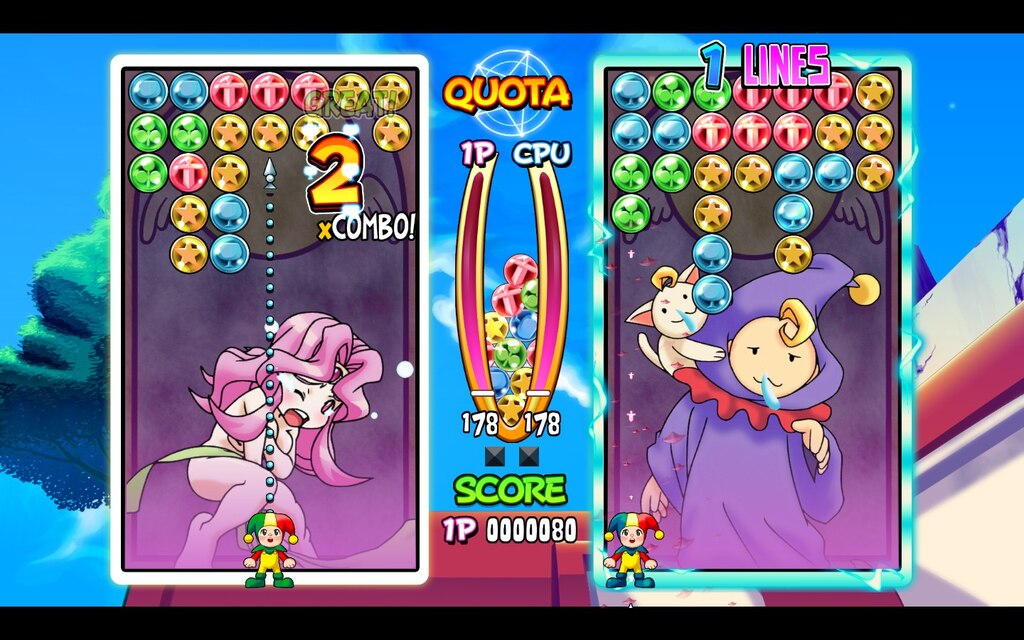
The last time anyone saw Magical Drop was this fifth installment from 2012, which was developed by French studio Golgoth and published by UTV Ignition. The game ended up as a PC exclusive despite being set for release on Xbox Live Arcade and PlayStation Network; it’s likely that the negative reception the PC version caused the cancellation of these ports.
Fundamentally, Magical Drop V isn’t a terrible game — it was actually my first encounter with the series, and was enough to get me interested in trying the other installments — but its general lack of polish, bugs, mistranslations of established series lore, terrible online code and failure to live up to the rest of the series meant that it very much ended up being the black sheep of the series. And, indeed, it seems to be an entry in the series that current rights holder G-Mode seems keen to forget about, since it was delisted from Steam in 2020.
One interesting — and, in retrospect, ill-advised — feature of Magical Drop V is that it attempts to incorporate elements of a cancelled Data East puzzler called Ghostlop, going so far as to include characters from Ghostlop who use mechanics from their game rather than Magical Drop. Trouble is, Ghostlop’s mechanics are so wildly different to those of Magical Drop that a match between a Magical Drop character and a Ghostlop character is completely unbalanced, making for an unenjoyable and frustrating experience.
Here’s hoping Magical Drop VI marks a return to form for the series, eh?
Join The Discussion
Rice Digital Discord
Rice Digital Twitter
Rice Digital Facebook
Or write us a letter for the Rice Digital Friday Letters Page by clicking here!
Disclosure: Some links in this article may be affiliate links, which means we may earn a small commission if you make a purchase after clicking on them. This is at no additional cost to you and helps support Rice Digital!
- Letter from the Editor: passing the torch - June 30, 2023
- Super Woden GP 2 is looking promising - June 30, 2023
- Inti Creates is making a 32 bit-style Love Live action platformer - June 26, 2023




